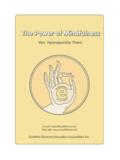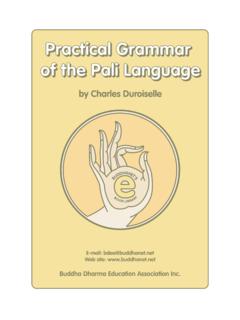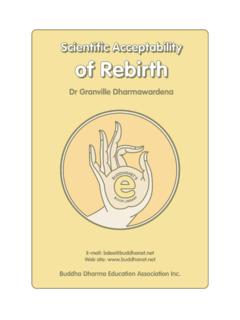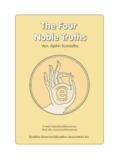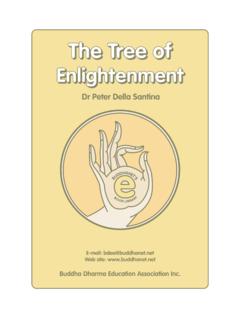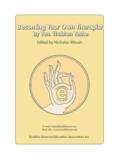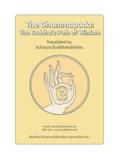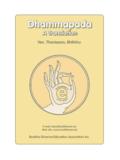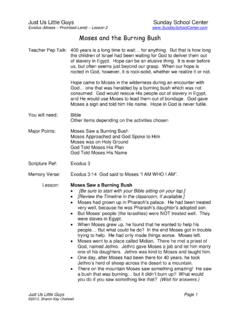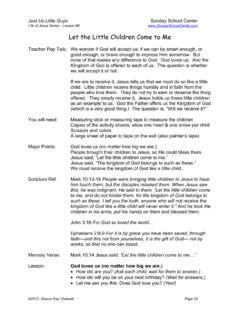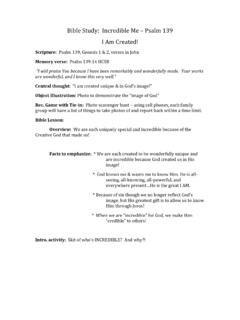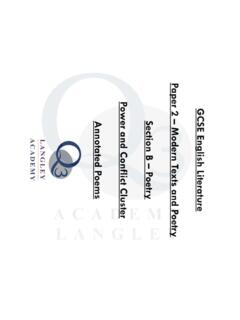Transcription of The Dhammapada - BuddhaNet
1 EBUDDHANET'SBOOKLIBRARYE-mail: site: Dharma Education Association byAcharya BuddharakkhitaThe Dhammapada :The Buddha's Path of WisdomThe Dhammapada :The Buddha's Path of Wisdom The Dhammapada : The Buddha s Path of Wisdom Translated from the Pali by Acharya Buddharakkhita Introduction by Bhikkhu Bodhi Copyright 1985, Buddhist Publication Society Kandy, Sri Lanka For free distribution only. You may print copies of this work for your personal use. You may re-format and redistribute this work for use on computers and computer networks, provided that you charge no fees for its distribution or use. Otherwise, all rights reserved. 1 Contents Preface by Acharya Buddharakkhita 2 Introduction by Bhikkhu Bodhi 5 Chapters: 1. The Pairs (vv. 1-20) 23 2. Heedfulness (vv. 21-32) 26 3. The Mind (vv.)
2 33-43) 28 4. Flowers (vv. 44-59) 30 5. The Fool (vv. 60-75) 33 6. The Wise Man (vv. 76-89) 35 7. The Arahat: The Perfected One (vv. 90-99) 37 8. The Thousands (vv. 100-115) 39 9. Evil (vv. 116-128) 41 10. Violence (vv. 129-145) 43 11. Old Age (vv. 146-156) 45 12. The Self (vv. 157-166) 47 13. The World (vv. 167-178) 49 14. The Buddha (vv. 179-196) 51 15. Happiness (vv. 197-208) 54 16. Affection (vv. 209-220) 56 17. Anger (vv. 221-234) 58 18. Impurity (vv. 235-255) 60 19. The Just (vv. 256-272) 63 20. The Path (vv. 273-289) 65 21. Miscellaneous (vv. 290-305) 68 22. The State of Woe (vv. 306-319) 70 23. The Elephant (vv. 320-333) 72 24. Craving (vv. 334-359) 74 25. The Monk (vv. 360-382) 78 26. The Holy Man (vv. 383-423) 82 2 Preface by Acharya Buddharakkhita The Dhammapada is the best known and most widely esteemed text in the Pali Tipitaka, the sacred scriptures of Theravada Buddhism.
3 The work is in-cluded in the Khuddaka Nikaya ( Minor Collection ) of the Sutta Pitaka, but its popularity has raised it far above the single niche it occupies in the scriptures to the ranks of a world religious classic. Composed in the ancient Pali language, this slim anthology of verses constitutes a perfect compendium of the Buddha s teaching, comprising between its covers all the essen-tial principles elaborated at length in the forty-odd volumes of the Pali Canon. According to the Theravada Buddhist tradition, each verse in the Dhammapada was originally spoken by the Buddha in response to a particular episode. Ac-counts of these, along with exegesis of the verses, are preserved in the classic commentary to the work, compiled by the great scholiast Bhadantacariya Buddhaghosa in the fifth century on the basis or material going back to very ancient times.
4 The con-tents of the verses, however. transcend the limited and particular circumstances of their origin, reaching out through the ages to various types of people in all the diverse situations of life. For the simple and unsophis-ticated the Dhammapada is a sympathetic counselor; for the intellectually overburdened its clear and direct teachings inspire humility and reflection; for the ear-nest seeker it is a perennial source of inspiration and 3practical instruction. Insights that flashed into the heart of the Buddha have crystallized into these lumi-nous verses of pure wisdom. As profound expressions of practical spirituality, each verse is a guideline to right living. The Buddha unambiguously pointed out that whoever earnestly practices the teachings found in the Dhammapada will taste the bliss of emancipation.
5 Due to its immense importance, the Dhamma-pada has been translated into numerous languages. In English alone several translations are available, including editions by such noted scholars as Max Mul-ler and Dr. S. Radhakrishnan. However, when pre-sented from a non-Buddhist frame of reference, the teachings of the Buddha inevitably suffer some dis-tortion. This, in fact, has already happened with our anthology: an unfortunate selection of renderings has sometimes suggested erroneous interpretations, while footnotes have tended to be judgmental. The present translation was originally written in the late 1950 s. Some years earlier, while consulting a number of English-language editions of the Dhamma-pada, it was observed that the renderings were either too free and inaccurate or too pedantic, and it was therefore felt that a new translation avoiding these two extremes would serve a valuable purpose.
6 The finished result of that project, presented here, is a humble at-tempt by a practicing follower of the Buddha to trans-mit the spirit and content, as well as the language and style, of the original teachings. In preparing this volume I have had access to numerous editions and translations of the Dhamma-pada into various languages, including Sanskrit, Hindi, 4 Bengali, Sinhala, Burmese and Nepali. I particularly benefited from the excellent translations of the work by the late Venerable Narada Mahathera of Vajira-rama, Colombo. Sri Lanka, and Professor Bhagwat of Poona, India; To them I acknowledge my debt. A few verses contain riddles, references or analogies that may not be evident to the reader. The meanings of these are provided either in parenthesis or notes, and for their interpretation I have relied on the explanations given in Bhadantacariya Buddhaghosa s commentary.
7 Verses discussed in the notes are indicated in the text by an asterisk at the end of the verse . A first edition of this translation was published in 1959 and a second in 1966, both by the Maha Bodhi Society in Bangalore, India. For this third edition, the translation has undergone considerable revision. The newly added subtitle, The Buddha s Path of Wis-dom, is not literal, but is fully applicable on the ground that the verses of the Dhammapada all originate from the Buddha s wisdom and lead the one who fol-lows them to a life guided by that same wisdom. I am grateful to the editors of the Buddhist Pub-lication Society for their helpful suggestions. and to the Society itself for so generously undertaking the publication of this work. I make this offering of Dhamma in grateful memory of my teachers, parents and relatives, de-parted and living.
8 May they find access in the Bud-dha s Dispensation and attain Nibbana! May all beings be happy! Acharya Buddharakkhita 5 Introduction by Bhikkhu Bodhi From ancient times to the present, the Dhamma-pada has been regarded as the most succinct expres-sion of the Buddha s teaching found in the Pali Canon and the chief spiritual testament of early Buddhism. In the countries following Theravada Buddhism, such as Sri Lanka, Burma and Thailand, the influence of the Dhammapada is ubiquitous. It is an ever-fecund source of themes for sermons and discussions, a guidebook for resolving the countless problems of everyday life, a primer for the instruction of novices in the monasteries. Even the experienced contemplative, withdrawn to forest hermitage or mountainside cave for a life of meditation, can be expected to count a copy of the book among his few material possessions.
9 Yet the admiration the Dhammapada has elicited has not been confined to avowed followers of Buddhism. Wherever it has become known its moral earnestness, realistic understanding of human life, aphoristic wis-dom and stirring message of a way to freedom from suffering have won for it the devotion and veneration of those responsive to the good and the true. The expounder of the verses that comprise the Dhammapada is the Indian sage called the Buddha, an honorific title meaning the Enlightened One or the Awakened One. The story of this venerable person-age has often been overlaid with literary embellish-ment and the admixture of legend, but the historical essentials of his life are simple and clear. He was born in the sixth century , the son of a king ruling over a small state in the Himalayan foothills, in what is now Nepal.
10 His given name was Siddhattha and his family name Gotama (Sanskrit: Siddhartha Gautama). Raised 6in luxury, groomed by his father to be the heir to the throne, in his early manhood he went through a deeply disturbing encounter with the sufferings of life, as a result of which he lost all interest in the pleasures and privileges of rulership. One night, in his twenty-ninth year, he fled the royal city and entered the forest to live as an ascetic, resolved to find a way to deliverance from suffering. For six years he experimented with different systems of meditation and subjected himself to severe austerities, but found that these practices did not bring him any closer to his goal. Finally, in his thirty-fifth year, while sitting in deep meditation be-neath a tree at Gaya, he attained Supreme Enlighten-ment and became, in the proper sense of the title, the Buddha, the Enlightened One.
